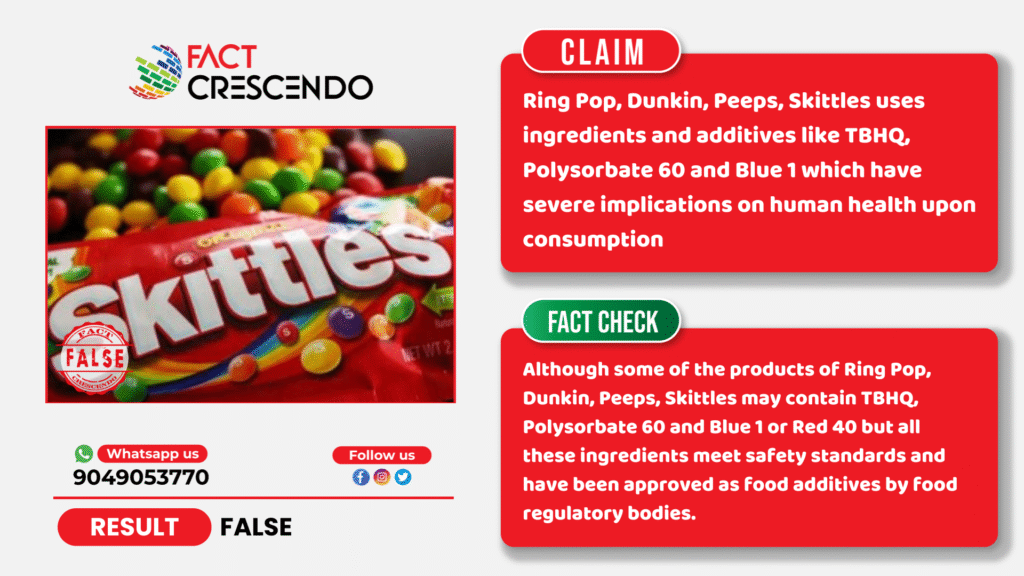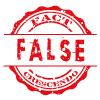
Currently, a video is going viral on social media, claiming that famous brands like Ring Pop Gummy, Dunkin, Peeps, Skittles etc have ingredients like TBHQ and additives like Blue 40 and Polysorbate 60 which causes serious health issues.
However, Fact Crescendo found the claim to be false. All the ingredients and additives mentioned in the post meet the safety standard and are safe when consumed within the prescribed limits. Further, not all the mentioned brands or its products contain TBHQ or Blue 40 and Polysorbate 60.
What’s the claim?
Sharing the video a social media user claimed, “THBQ suppresses a child’s immune system and triggers behavioral issues like hyperactivity and worsen ADHD. Additives like Blue 40 interact directly with brain cells and can alter mood, attention span and nervous system. Polysorbate 60 causes intestinal inflammation like leaky gut and metabolic issues.”
Fact Check-
First, we tried to find out which of the mentioned brands uses TBHQ, Blue 40 and Polysorbate 60 as its ingredients. As these brands have a wide range of products, some of them have the ingredients mentioned in the post. While Ring Pop Gummy Bunnies and Dunkin Chocolate eggs do not contain TBHQ or Blue 40, other brands like Peeps and Skittles may have these ingredients.
Lets check the safety of each of the mentioned ingredients:
TBHQ: Tertiary butylhydroquinone, or TBHQ, is an additive to preserve processed foods. It acts as an antioxidant which protects foods with iron from discoloration. It is used to extend shelf life and prevent rancidity of the products.
The EFSA Panel reviewed the safety of TBHQ (E 319), a food additive allowed in the EU with a safe daily intake limit of 0.7 mg per kilogram of body weight. While past assessments found that adult exposure stayed within this limit, there was concern that infants consuming infant formula with TBHQ might exceed the limit. To refine the assessment, EFSA analyzed new data on how much TBHQ is used in foods and how much people actually consume. The results showed that, at maximum allowed levels, toddlers and children could exceed the safe limit. However, in more realistic scenarios, the safe limit was not exceeded for any group.
FDA approved TBHQ as a food additive and set specific conditions for its safe use. As per FDA, TBHQ must have a melting point of at least 126.5°C and be at least 99% pure. It should be used as an antioxidant, either alone or with BHA and BHT, to prevent oxidation in foods and the total amount of antioxidants, including TBHQ, in a food must not exceed 0.02% of the fat or oil content in the food.
Although it is true that TBHQ can cause health issues, according to food safety regulatory bodies, it is safe when consumed within approved quantities.
Blue 40: We found that there is no additive under the name of Blue 40. Either it is Blue 1 , Blue 2 or Red 40
Red 40 is a synthetic dye which is used to add bright red color to foods and drinks. FDA has permitted the use of Red 40 in cereals, beverages, gelatins, puddings, dairy products and confections.
After reviewing Red 40’s safety European Food Safety Authority (EFSA) had declared it safe to consume. Although there were studies which showed DNA damage in mice upon consumption of the additive, EFSA did not find any link between Red 40 and serious health issues in humans, even when this additive is consumed beyond human consumption limit. To ensure safety, EFSA has approved consumption of 0-7 mg per kilogram of body weight of Red 40. Based on current evidence, experts consider Red 40 safe to use as a food additive when consumed in normal amounts.
Blue 1: The EFSA reviewed the safety of Blue 1, also known as Brilliant Blue FCF (E 133). It was previously approved with an acceptable daily intake (ADI) of 10 mg/kg body weight per day, set in 1984. After reviewing new data on how the dye is absorbed, processed, and its effects on health, the EFSA decided to lower the ADI to 6 mg/kg body weight per day. This decision was based on updated studies showing the dye is safe at this level. The EFSA also found that most people’s intake is below this new ADI.
Polysorbate 60: According to the Code of Federal Regulation’s report, Polysorbate 60 is made by combining stearic and palmitic acids with sorbitol and polyoxyethylene. It helps mix ingredients like oil and water and is used in various food products. It is approved for safe use in certain foods. The regulatory body has set limits on the use of Polysorbate 60 in different foods. For example, in cakes and cake mixes, it cannot be more than 0.46% of the dry weight. In icings and fillings, the total amount should not exceed 1% when mixed with similar emulsifiers. These rules ensure Polysorbate 60 is used safely in food.
FDA has also approved the use of Polysorbate 60 as food additive and categorised it as Generally Recognized as Safe (GRAS).
Conclusion:
Fact Crescendo found the claim to be false. Although some of the products of Ring Pop, Dunkin, Peeps, Skittles may contain TBHQ, Polysorbate 60 and Blue 1 or Red 40 but all these ingredients meet safety standards and have been approved as food additives by food regulatory bodies.

Title:TBHQ, Blue 40 and Polysorbate 60 in Ring Pop, Dunkin, Skittles, and other brands meet safety standards.
Fact Check By: Siddharth SahuResult: False


